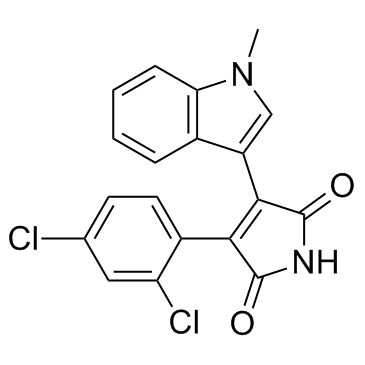SB216763

SB216763 structure
|
Common Name | SB216763 | ||
|---|---|---|---|---|
| CAS Number | 280744-09-4 | Molecular Weight | 371.217 | |
| Density | 1.5±0.1 g/cm3 | Boiling Point | 598.1±50.0 °C at 760 mmHg | |
| Molecular Formula | C19H12Cl2N2O2 | Melting Point | 287-288.6ºC(lit.) | |
| MSDS | Chinese USA | Flash Point | 315.5±30.1 °C | |
| Symbol |

GHS07 |
Signal Word | Warning | |
Use of SB216763SB 216763 is potent, selective and ATP-competitive GSK-3 inhibitor with IC50s of 34.3 nM for both GSK-3α and GSK-3β. |
| Name | 3-(2,4-dichlorophenyl)-4-(1-methylindol-3-yl)pyrrole-2,5-dione |
|---|---|
| Synonym | More Synonyms |
| Description | SB 216763 is potent, selective and ATP-competitive GSK-3 inhibitor with IC50s of 34.3 nM for both GSK-3α and GSK-3β. |
|---|---|
| Related Catalog | |
| Target |
GSK-3α:34.3 nM (IC50) GSK-3β:34.3 nM (IC50) |
| In Vitro | SB-216763 (10-20 µM) induces β-catenin mediated-transcription in a dose-dependent manner in HEK293 cells. SB-216763 (10, 15 and 20 µM) can maintain mESCs with a pluripotent-like morphology in long-term culture. SB-216763 (10 µM) can maintain J1 mESCs in a pluripotent state for more than a month[2]. SB-216763 inhibits GSK-3 with IC50 of 34 nM[3]. SB-216763 is equally effective at inhibiting human GSK-3α and GSK-3β[5]. |
| In Vivo | SB216763 (20 mg/kg, i.v.) significantly improves the survival of BLM-treated mice. Mice randomized to receive BLM plus SB216763 shows a noteworthy reduction, compared with BLM-treated mice. SB216763 (20 mg/kg, i.v.) reduces the magnitude of BLM-induced alveolitis[1]. SB 216763 (0.2 mg/kg, i.v.) with either 17β-E100 or Geni100 reverses the ceiling effect because these agents significantly reduce infarct size when the rabbits' hearts are submitted to 30-min CAO[4]. |
| Cell Assay | MESCs maintained with LIF or 10 µM SB-216763 for more than a month are resuspended at 40,000 cells/mL in LIF-free mESC medium. EBs are prepared by a hanging drop procedure. Briefly, 20 µL drops containing mESCs are pipetted on the inside of a 10-cm Petri dish lid. The lids are placed onto Petri dishes containing 10 mL of HBSS and the EBs are allowed to form and grow for 4 days in the incubator. After 4 days, 15-20 EBs are transferred to a well containing LIF-free mESC medium in a 24-well plate. The medium is exchanged every two days and autonomously beating cell aggregates are observed and counted. |
| Animal Admin | Mice are allocated to four groups (n=12/group) as follows: 1) intratracheal saline + vehicle (25% dimethyl sulfoxide, 25% polyethylene glycol, and 50% saline), 2) intratracheal saline + SB216763 (20 mg/kg) dissolved in vehicle, 3) intratracheal BLM (3 U/kg) + vehicle, and 4) intratracheal BLM + SB216763 (20 mg/kg) in vehicle. Another set of experiments to assess cytokine expression by reverse transcription-PCR is conducted in the mice (n=12/group) to receive 1) intratracheal saline + vehicle, 2) intratracheal BLM, and 3) intratracheal BLM + SB216763. To induce pulmonary fibrosis, BLM is intratracheally administered in mice (n=15/group) on day 0. BLM and saline-treated mice are administered with SB216763 dissolved in vehicle or vehicle alone intravenously at day 0 and then intraperitoneally twice a week until day 28. Mice are sacrificed by CO2 inhalation on days 2, 7, and 28. In the terminal deoxynucleotidyl transferase dUTP nick-end labeling (TUNEL) experiments, the cohorts of mice are as follows: saline-treated (n=6), BLM-treated (n=6), and BLM + SB216763-treated (n=6). |
| References |
| Density | 1.5±0.1 g/cm3 |
|---|---|
| Boiling Point | 598.1±50.0 °C at 760 mmHg |
| Melting Point | 287-288.6ºC(lit.) |
| Molecular Formula | C19H12Cl2N2O2 |
| Molecular Weight | 371.217 |
| Flash Point | 315.5±30.1 °C |
| Exact Mass | 370.027588 |
| PSA | 51.10000 |
| LogP | 4.79 |
| Appearance of Characters | orange |
| Vapour Pressure | 0.0±1.7 mmHg at 25°C |
| Index of Refraction | 1.702 |
| InChIKey | JCSGFHVFHSKIJH-UHFFFAOYSA-N |
| SMILES | Cn1cc(C2=C(c3ccc(Cl)cc3Cl)C(=O)NC2=O)c2ccccc21 |
| Storage condition | −20°C |
| Water Solubility | DMSO: 20 mg/mL, soluble |
| Symbol |

GHS07 |
|---|---|
| Signal Word | Warning |
| Hazard Statements | H315-H319-H335 |
| Precautionary Statements | P261-P305 + P351 + P338 |
| Personal Protective Equipment | dust mask type N95 (US);Eyeshields;Gloves |
| Hazard Codes | Xi: Irritant; |
| Risk Phrases | R36/37/38 |
| Safety Phrases | 26-36 |
| RIDADR | NONH for all modes of transport |
| WGK Germany | 3 |
| HS Code | 2933990090 |
| HS Code | 2933990090 |
|---|---|
| Summary | 2933990090. heterocyclic compounds with nitrogen hetero-atom(s) only. VAT:17.0%. Tax rebate rate:13.0%. . MFN tariff:6.5%. General tariff:20.0% |
|
Lenticular mitoprotection. Part B: GSK-3β and regulation of mitochondrial permeability transition for lens epithelial cells in atmospheric oxygen.
Mol. Vis. 19 , 2451-67, (2013) Loss of integrity of either the inner or outer mitochondrial membrane results in the dissipation of the mitochondrial electrochemical gradient that leads to mitochondrial membrane permeability transit... |
|
|
Involvement of the glycogen synthase kinase-3 signaling pathway in TBI pathology and neurocognitive outcome.
PLoS ONE 6(9) , e24648, (2011) Traumatic brain injury (TBI) sets in motion cascades of biochemical changes that result in delayed cell death and altered neuronal architecture. Studies have demonstrated that inhibition of glycogen s... |
|
|
Selective small-molecule inhibitors of glycogen synthase kinase-3 activity protect primary neurones from death.
J. Neurochem. 77 , 94-102 , (2001) The phosphatidylinositol 3-kinase (PI 3-kinase)/protein kinase B (PKB; also known as Akt) signalling pathway is recognized as playing a central role in the survival of diverse cell types. Glycogen syn... |
| 3-(2,4-Dichlorophenyl)-4-(1-methyl-1H-indol-3-yl)-1H-pyrrole-2,5-dione |
| 1H-Pyrrole-2,5-dione, 3-(2,4-dichlorophenyl)-4-(1-methyl-1H-indol-3-yl)- |
| S1075_Selleck |
| SB 216763 |
| SB216763 |